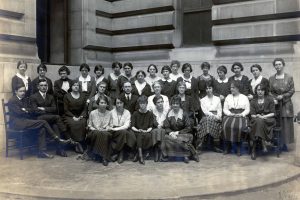At the Rare Book and Manuscript Library (RBML), we are fortunate to have dedicated and curious students who help us maintain and provide access to our collections. Just this past year, Itzel Franco (CC 2026) and Sarah Noon (GS 2024) helped us improve the condition and description of a brittle but valuable collection of records from the NYPL Library School.
How was the NYPL Library School connected to Columbia?
Columbia University has had two library schools. The first, the School of Library Economy at Columbia, operated from 1887 to 1889. Columbia severed ties with Melvil Dewey and he moved the School to Albany, where it became the New York State Library School. When the New York Public Library building on 42nd Street (now the Schwarzman Building) opened in 1911, it included space for a library school. Thanks to a generous gift from Andrew Carnegie, NYPL started a school to train future staff members at their own headquarters. In 1926, the School in Albany and the NYPL school merged and became Columbia’s second library school, the School of Library Service (SLS) at Columbia. At the RBML, we hold the records of those two predecessor institutions and the Columbia SLS, which closed in 1993.

What kinds of records are included in the NYPL Library School collection?
The NYPL library school records include course related materials such as reading lists, syllabi, examinations, practice work, and related printed materials. The student records include applications, letters of recommendation, placement information, and correspondence with alumni, which the NYPL kept updating through the late 1960s. There is also correspondence and lecture notes of Mary Wright Plummer, Principal of the School, 1911-1916, and lecture notes of Mary Louisa Sutliff who taught at the School, 1911-1926. The files were transferred to the RBML in 1981.
What kind of work did the RBML students engage in?
The first step in this project was for our students to do some preservation intervention work. While the original collection had been organized and rehoused in archival boxes in the 1980s, the records were still stored in the original 1910s-1920s folders. These had become very brittle and fragile. Itzel and Sarah assessed the condition of the 1980s boxes: did the boxes need new labels? Were they overstuffed? Did they have any tears or were broken? Then, they rehoused the NYPL student files into new archival folders. The next step in this project was to capture the names of all the former students. Here Itzel and Sarah had to learn about the naming conventions of the past or the “Mrs. Problem”.
What is the “Mrs. Problem”?
As our colleagues pointed out in this blog, “It was once accepted practice to call married women by their husbands’ names, with the honorific “Mrs.” attached–for example, “Mrs. Franklin Delano Roosevelt.” The student names in the NYPL files followed this now outdated practice so, for example, for a folder labeled “Garmey, Mrs. C. Ronald,” we asked the students to find other names in the contents of the folder. In this case, the students found “De Huff, Harriet Louise” as she was known while a student. The students learned about these naming practices and captured any and all of the graduates’ names so that files could be discovered by future researchers.
How are these NYPL Library School records used?
In 2019, Barbara Hochman looked at the student records in this collection to better understand Nella Larsen. In 1922, Larsen was an assistant at the 135th Street branch of the NYPL (and not yet an author). The application form asks prospective students to list 10 books that they’ve read in the last two years. Hochman uses these lists to gain some insights on Larsen, who became the first Black student in the NYPL Library School.

Who else is in this collection?
In 1925, a few years after Larsen, another one of the 135th Street branch assistants applied to the library school. This time, it was Pura Belpré, who became the first Puerto Rican librarian in the NYPL. Belpré’s file, fittingly for this project, is filed under “White” since she married Clarence Cameron White in 1943. You can listen to Belpré recount her days at the NYPL and about her many children’s books based on Puerto Rican folktales in this oral history from 1976. The Pura Belpré papers are held at the Centro Library & Archives, Center for Puerto Rican Studies at Hunter College.
What’s next?
This year, our students will engage in a similar project as they rehouse and inventory the student records of the other predecessor school, the New York State Library School.